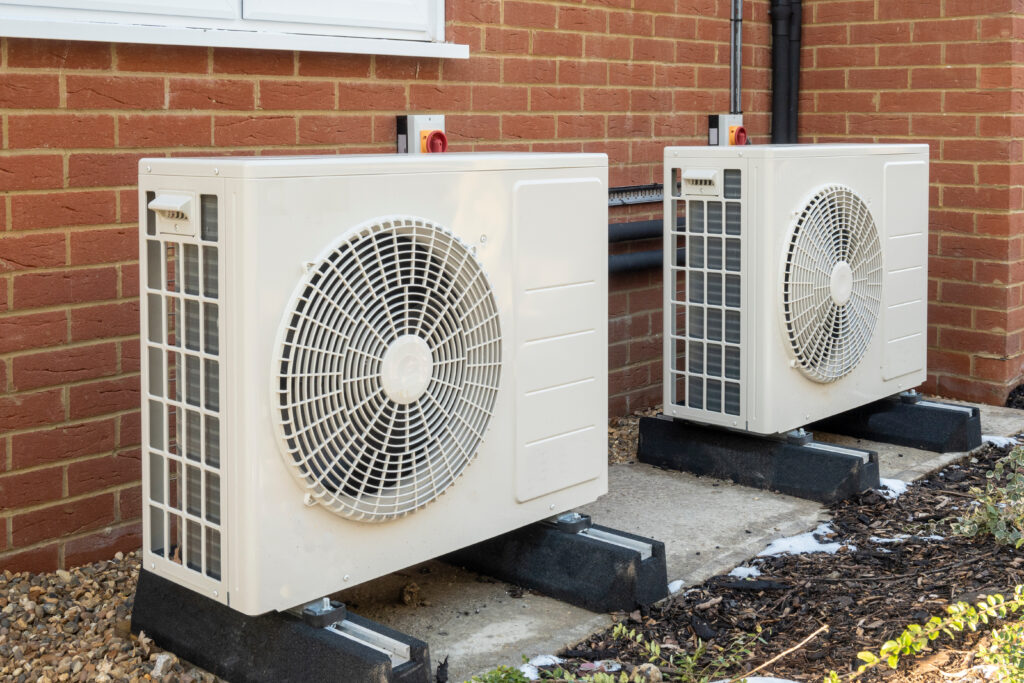Two air source heat pumps installed on the exterior of a house. Stock.adobe.com photo by Nimur.
As an architect, much of my career has revolved around creating buildings that Maryland’s families and residents can find joy and comfort in. I’ve learned that well-designed buildings — from schools and commercial spaces to our homes — can impact one’s health, safety, and quality of life.
That’s why I’m encouraged by new Building Energy Performance Standards (BEPS) included in Maryland’s Climate Solutions Now Act. These standards will ensure that the state’s largest buildings such as commercial businesses and multifamily housing, both new and existing, are designed with or upgraded to current energy efficient equipment that reduces pollution. These standards also focus on a more efficient building envelope to reduce the demand for energy to heat and cool them.
Investments in energy-efficient buildings will pay dividends for decades to come, yielding lower utility bills, improved air quality, and reduced climate pollution. Yet, opponents have tried to water down, or even repeal, these standards despite the benefits they will bring to Marylanders.
It’s time now for the state to finalize these standards. Further efforts to roll them back would undermine a key component of the state’s landmark climate legislation and make it difficult, if not impossible, for Maryland to meet its goal of reducing climate emissions by 60% by 2031 and achieving net-zero by 2045.
Compared to the state’s power plants, burning fossil fuels in Maryland’s buildings releases three times as much health-harming nitrogen oxides (NOx), a common family of pollutants that contribute to smog. Breathing in this smog can exacerbate respiratory illnesses, particularly asthma, leading to costly visits to the emergency room. Pollution from buildings also contributes 30% to the state’s greenhouse gas emissions.
Upgrading buildings with zero-emission technologies such as all-electric heat pumps will provide highly efficient heating and cooling, and will enable our buildings to be powered by renewable energy like wind and solar. These upgrades will improve indoor comfort during extreme heat events, which are likely to increase in frequency and severity in the coming years.
Renters raise alarm over high levels of nitrogen dioxide in apartments
On top of climate and health benefits, efficient buildings reduce energy bills, which is especially important for low-income Maryland residents living in multifamily housing. Without these standards, landlords have little incentive to upgrade their equipment to healthier, more efficient technology, leaving renters with high heating and cooling bills. Efficient electric equipment can help renters save real money: Compared to fossil fuel appliances such as gas furnaces, modern air-source heat pumps are two to four times more energy efficient in the winter and use less electricity in the summer compared to traditional air conditioning.
Weatherization improvements, like the ones new building efficiency standards call for, enhance a building’s insulation, reducing heat loss and lowering energy use. That means that Maryland residents will realize cost savings that puts money back into their pockets, and those efficiency upgrades will remain with the buildings for the rest of their expected use life.
Opponents of the new standards are pushing to keep some outdated, inefficient electric heating equipment which is cheaper to install but leads to dramatically higher utility bills for renters and small business tenants. Some others are choosing to replace equipment with fossil fuel based systems that may remain in use for the next 15 to 25 years. Lawmakers and regulators must protect provisions of the law (Energy Use Intensity Standards) that ensure only the best clean-energy electric equipment is installed in buildings.
Thanks to robust state and federal incentives for Maryland homeowners and building owners, there is no better time than the present to increase the efficiency of our buildings. New federal and state incentives will reduce the upfront costs of energy efficiency upgrades. Federal benefits from the Inflation Reduction Act will provide tax credits and rebates for owners looking to weatherize their buildings or install electric heat pumps and appliances. In addition, Maryland’s EmPOWER energy efficiency program will provide additional financial incentives to building owners to pursue clean energy upgrades.
Across the country, there is increased demand for better, more climate-resilient building standards. According to data from the American Institute of Architects, net-zero energy projects increased by 345% from 2018 to 2022. More and more people are realizing that buildings can be modernized cost-efficiently so that they can yield health and climate benefits.
Maryland residents should not be missing out on this opportunity. After years of fruitful discussions, Maryland legislative and administrative leaders have developed a strong framework to upgrade our largest buildings. Now is the time to implement the Climate Solutions Now Act and upgrade our buildings to be cleaner, healthier and more efficient.

